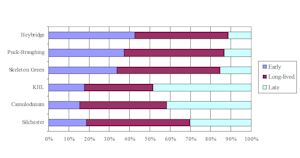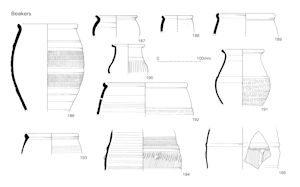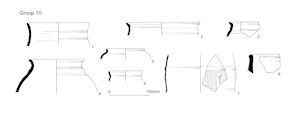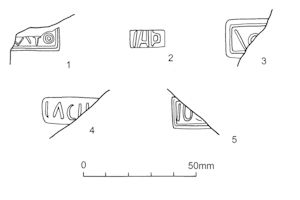
Cite this as: Compton, J. 2015, The Late Iron Age Gaulish Imports, in M. Atkinson and S.J. Preston Heybridge: A Late Iron Age and Roman Settlement, Excavations at Elms Farm 1993-5, Internet Archaeology 40. http://dx.doi.org/10.11141/ia.40.1.compton1
Continental imports of Late Iron Age date form a significant proportion of the Elms Farm assemblage. Study of these imports was undertaken as part of a research aim to refine dating for the Late Iron Age period and to characterise the settlement at Heybridge during this period. A wide range and variety of pottery types were recorded, not least of which are the Dressel 1 amphoras. However, pottery from three main sources is considered here: Central Gaulish wares (847 sherds, 10.3kg), Gallo-Belgic wares (1054 sherds, 10.8kg) and north Gaulish white ware (786 sherds, 5.9kg).
These micaceous wares have an accepted date of arrival in Britain of c. 25-20 BC (Rigby 1986b, 270). Small amounts were recorded for Ceramic Phase 1 (c. 50-15 BC), but there are much greater numbers in Ceramic Phase 2 (c. 15 BC-AD 20). The assemblage from Heybridge compares well with those from Camulodunum, Skeleton Green and Silchester (Table 9). A full range of vessels occurred at Heybridge and includes cream-slipped flagons, micaceous platters, mica-coated jars and red-slipped vessels. Red-slipped micaceous ware (micaceous terra rubra) is an uncommon site find, imported only in the final decades of the 1st century BC and absent at King Harry Lane (Rigby 1989, 119), although other Central Gaulish micaceous wares were present there in small numbers. The cemetery at King Harry Lane was dated AD 1-60 but, following reappraisal of the brooch evidence, Haselgrove and Millett (1997, 292) suggest that a revised date range of c. 10/1 BC-AD 40/50 can be assigned. Micaceous terra rubra is present in the Welwyn Garden City burial (Stead 1967), at Skeleton Green (Rigby 1981a, 171), Baldock (Rigby 1986a, 232) and Silchester (Timby 2000, 210). A number of vessels in micaceous terra rubra, mainly platters, have been found in the Puckeridge-Braughing area (Rigby 1979, 105; 1981a, 171; 1981b, 332) and settlements in this area are thought to originate before c. 30 BC (Partridge 1981, 353). Assemblages of Central Gaulish wares from Puckeridge-Braughing and Elms Farm are broadly comparable (Figure 307), suggesting a similar pattern of early importation at Heybridge.

Micaceous platters (along with Cam 165 cream-slipped flagons) were the first Central Gaulish vessel types to be imported, and micaceous terra rubra was thought to be an earlier arrival than micaceous terra nigra (Rigby 1988, table 11). The evidence at Heybridge, though, suggests that micaceous terra nigra platters are contemporary with both micaceous terra rubra and the flagons. Numbers of each in the stratified assemblage are roughly equal. Mica-coated Central Gaulish jars (Cam 102/Cam 262) appeared slightly later at Heybridge, in line with the accepted arrival date of c. 10 BC (Rigby 1988, 112, table 11). There are platter form variations in micaceous terra nigra, similar to examples found at Silchester (Timby 2000, fig. 110.159-61), and occurring in contexts dated to the second quarter of the 1st century AD. This accords with the date of the form variations at Silchester, and perhaps indicates continued manufacture of the ware beyond AD 25 at different Gaulish production centres. In confirmation, Rigby (1988, 111) has suggested that a number of production sites were involved in producing micaceous terra nigra, in view of the variations in the fabric, as well as in the forms. Of interest is the number of 'bobbin'-shaped bowls, Cam 51, recorded in this fabric, which are very rare outside Camulodunum. At least fifteen examples are present, exceeding the number at Skeleton Green, where the occurrence of twelve was considered notable (Rigby 1981a, 161).
Central Gaulish ware seems to be uncommon in Essex; few published examples can be found outside the large collection at Camulodunum (Hawkes and Hull 1947, tables, pp. 277-81). The gazetteer of find-spots in the Heybridge area (Wickenden 1986, 53-9) draws attention to the Fitch Collection, amassed in 1887 during work on the new railway line at Langford Junction. 'Barrowloads' of pottery are said to have been recovered from the site (Wickenden 1986, 57), which lies immediately to the south-west of the Elms Farm excavations. Central Gaulish wares appear to be among those listed, although much of the collection cannot now be traced. The gazetteer lists no other Central Gaulish find-spots, apart from a possible Cam 165 flagon, which more than likely came from the New Cemetery (Wickenden 1986, 55). A recent survey of sites local to Heybridge (Wallace 1998, 155, table 8) has indicated that most occurrences of imported pottery of Late Iron Age date are restricted to amphoras. It may be worth noting that Central Gaulish ware appears to occur mostly where Dressel 1 is relatively common, perhaps indicating that the early import of both was linked.
Gallo-Belgic pottery, in the form of terra rubra and terra nigra, arrived at Heybridge slightly later than Central Gaulish wares, and continued in use long after most Central Gaulish wares probably ceased to be imported, c. AD 25 (Rigby 1989, 120). The terra rubra platter types recovered from pyre-debris pit 15417 were probably in production by c. 15 BC (Rigby 1989, 121) and standardised by 10 BC (Rigby 1989, 123). These platters were likely to have been among the first Gallo-Belgic arrivals at Heybridge, but quantities of Gallo-Belgic ware very soon matched those of Central Gaulish wares. There is almost twice as much terra rubra as there is terra nigra (ratio 1.75:1), and with more diversity of vessel form. Higher quantities of terra rubra and greater vessel diversity are thought to indicate an earlier settlement date. The ratio of terra rubra to terra nigra at Gatesbury Track, Hertfordshire, was 3:1 (Rigby 1979,, 105), where platters in the earlier micaceous terra rubra were also found (Rigby 1979, 107; fig. 33.2, 9). Such a high proportion of terra rubra was thought notable, since the norm for British sites has been estimated at 1:4 (Rigby 1979, 105). Comparison of Cam forms from a range of sites (Table 9) shows that the assemblage at Elms Farm is comparable with those at Skeleton Green and Silchester. The most numerous platter forms are Cam 2 and Cam 5, in both terra rubra and terra nigra, but the later Cam 16 is represented at Elms Farm by a single example and the Cam 14 is absent. The cup Cam 58 is also absent; this, and the two later platter forms, were standardised during the decade AD 30-40 (Rigby 1981a, 160) and are very common Claudio-Neronian forms. Potters' stamps (see below) occur on just three vessels, all in terra nigra, and the near absence of stamped Gallo-Belgic vessels is noteworthy.
| Cam form | Elms Farm | Camulodunum | Sheepen | Puck-Braugh | Skel. Green | Baldock | KHL | Silchester |
|---|---|---|---|---|---|---|---|---|
| 1 | 34 | 75 | 7 | 29 | 24 | 5 | 2 | 18 |
| 2 | 44 | 334 | 32 | 17 | 45 | 10 | 5 | 46 |
| 3 | 3 | 132 | 13 | 10 | 17 | 2 | 2 | 12 |
| 4 | 10 | 29 | 1 | 14 | 1 | 2 | 1 | - |
| 5 | 25 | 376 | 69 | 21 | 32 | 16 | 3 | 31 |
| 8 | 5 | 393 | 48 | - | 2 | 6 | 8 | 15 |
| 9 | 1 | 14 | - | - | - | - | - | - |
| 12 | 4 | 409 | 12 | 2 | 13 | 1 | 2 | 13 |
| 13 | 2 | 151 | 25 | - | 8 | 4 | 3 | 9 |
| 14 | - | 257+ | 108 | 1 | 2 | 15 | - | 37 |
| 16 | 1 | 142 | 32 | 4 | 1 | 8 | 1 | 27 |
| 51 | 15 | 90 | 2 | 5 | 12 | - | 1 | 3 |
| 52B | 4 | 16 | - | 2 | - | - | 1 | - |
| 56 | 9 | 675 | 111 | 9 | 50 | 10 | 25 | 37 |
| 58 | - | 67 | 17 | 1 | 3 | 2 | - | 6 |
| 74 | (2) | 38 | 6 | 13 | 1 | - | - | 17 |
| 79 | 3 | 19+ | 5 | 3 | - | 1 | 3 | 1 |
| 82 | 2 | 8 | 3 | 9 | 9 | 1 | 2 | ) 11 |
| 84 | 4 | 275+ | 23 | 18 | 18 | 6 | 4 | ) |
| 91 | 1 | 53+ | 4 | - | - | 3 | - | 2 |
| 102/262 | 23 | 100 | 8 | 8 | 49 | 1 | 3 | 29 |
| 109 | 3 | 22 | - | - | - | - | - | - |
| 112 | 30 | 609 | 48 | 61 | 61 | 7 | 5 | 74 |
| 113 | 47(68) | 2730+ | 150 | 23 | 100+ | 50+ | 65+ | # |
| 114 | 9 | 216 | 14 | 3 | 10 | 4 | 11 | 2(40) |
| 120 | (1) | 37 | - | - | - | - | - | 1 |
| 165 | 12 | 284 | 1 | 6 | 13 | 2* | 3 | 6 |
Note: Figures in brackets refer to occurrences represented by body sherds
*Neither example is a standard Cam 165 flagon
#Actual number not given, implying multitudinous examples
Terra rubra was gradually superseded by terra nigra, and platters in the latter can be found in British contexts dated as late as AD 85 (Rigby 1989, 123). The repertoire of vessels in terra nigra is much more restricted, with platters forming the majority. Terra nigra platters (61) at Elms Farm are double the number of those in terra rubra (32), even though many of the later terra nigra types were not recorded here. This mirrors the platter proportions noted at Skeleton Green (Table 10; Rigby 1981a, table III). The most common platter form in terra nigra is Cam 2; this platter type was long-lived, standardised in terra rubra by c. 10 BC and continuing in terra nigra until c. AD 65. Although there is a greater range of forms in terra rubra, beakers are less common than platters, with the ovoid butt beaker Cam 112 providing the most examples. This is the most common and widespread type (Rigby 1989, 134), although numbers at Heybridge do not compare well with either Skeleton Green or Silchester (Table 9). The tubby variety was standardised by AD 9 (Rigby 1989, 132) and the earliest types were found at Skeleton Green (Partridge 1981, figs 20-2, 27-8). The later form is smaller and more curvaceous and can be found in contexts dated to the Claudian period (Rigby 1989, 132). Both types are present at Elms Farm.

Of note is a butt beaker (Figure 292, EF194), found in pit 11450, which has applied round bosses over the rouletted decoration. Beakers with these bosses are not common, but examples have been found in several places, including Silchester (Timby 2000, fig. 135.710), King Harry Lane (Rigby 1989,, fig. 56.1A5; Burial 312), Skeleton Green (Rigby 1981a, 163) and Hatfield Peverel, Essex (Martin 1996a, fig. 4.1). At least eight of these bossed beakers have now been found in southern Britain and examples also occur in northern France (Rigby 1981a, 163). Where found in dated contexts, most examples are late Augustan and the Heybridge beaker is from a late 1st-century BC context. Girth and pedestal beakers are represented at Elms Farm by just a few examples, and cups, in both terra rubra and terra nigra, are equally rare. In this respect the assemblage is unlike that at Skeleton Green, where fifty examples of the Cam 56 cup were found, against only nine at Elms Farm. The reasons for this are unclear, but pottery cups, in general, seem to be scarce at Heybridge.
| Heybridge | Skeleton Green | King Harry Lane | Baldock | Sheepen | |
|---|---|---|---|---|---|
| Platters | |||||
| TR percentage | 34.4 | 34.7 | 32.3 | 26.4 | 22.8 |
| TN percentage | 65.6 | 65.3 | 67.7 | 73.6 | 77.2 |
| Cups | |||||
| TR percentage | 50.0 | 52.3 | 45.0 | 34.8 | 33.6 |
| TN percentage | 50.0 | 47.7 | 55.0 | 65.2 | 66.4 |
| Heybridge | Skeleton Green | King Harry Lane | Baldock | Sheepen | |||||
|---|---|---|---|---|---|---|---|---|---|
| Cup | Platter | Cup | Platter | Cup | Platter | Cup | Platter | Cup | Platter |
| 9.7 | 90.3 | 28.0 | 72.0 | 37.0 | 63.0 | 15.5 | 84.5 | 22.1 | 77.9 |
This does not appear to be as common at Heybridge as it is elsewhere. It is possible that this reflects the apparent hiatus in imported wares at Heybridge towards the end of the Late Iron Age (see Pattern of pottery supply). The peak of North Gaulish white ware imports into Britain appears to be at the time of the conquest and just after, when imports into Heybridge seem to be at their lowest. Vessel forms recorded include the Cam 113 butt beaker, by far the most common imported vessel type in this fabric, and flagons Cam 161 and Cam 154. Butt beakers were probably produced in northern Gaul (Rigby 1989, 137), but white ware flagons may have been made in either northern Gaul or Lower Germany in the 1st century AD (Rigby 1989, 141). The few white ware flagons at Elms Farm are in mid-1st century AD contexts. Production of the Cam 113 beaker commenced by c. 10 BC (Rigby 1986a, 232), and there are examples in late 1st-century BC contexts at Elms Farm (e.g. 8786, 15418). The earliest beakers are barrel-shaped, with short necks and wide mouths. Later beakers, which are the most common, have a recurved profile and are taller and slimmer. The prominent cordons on early vessels were gradually replaced by hollow cordons and then by grooved bands (Rigby 1989, 138). The later vessels continued into the Claudian period, and were also found at the Neronian fortresses of Usk and Exeter (Bidwell 1999, 490). Again, the early and later types were all recorded at Elms Farm. Also present is a beaker (KPG10, Figure 240, no. 7) that has barbotine vertical lines applied over the rouletted decoration. Presumably this example is allied to the beakers with applied round bosses described above, although these seem to be either in red fabrics or are red-slipped. This may indicate a separate source for the two varieties.

The Cam 114 beaker, which has barbotine 'herringbone' decoration and mica-coated rim, was barely represented at Elms Farm, mostly occurring residually in Roman contexts. This beaker type is thought to have a Gallo-Belgic source rather than North Gaulish, but body sherds without the distinctive decoration are likely to have been assigned the North Gaulish fabric code (NGWF). The date of importation into Britain is conventionally thought to be c. AD 10-50. This may account for the low number recorded (nine), although this figure accords with finds at Skeleton Green and King Harry Lane (Table 9).
The incidence of early Gaulish imports suggests an origin for the settlement at Heybridge towards the beginning of the last quarter of the 1st century BC. Figure 307 compares Heybridge with early settlements in Hertfordshire, whose dates of origin are put at c. 30 BC (Partridge 1981, 353). Comparison with King Harry Lane (c. 10/1 BC-AD 40/50) and Camulodunum (c. AD 5-60/1) appears to confirm a date of origin of before 10 BC. Further evidence, provided by the Elms Farm coins and other pottery types, e.g. the amphoras and Arretine, strengthens the case for a start date of c. 25-15 BC for Heybridge.
There is a curious decline in the level of continental imports during the second quarter of the 1st century AD. Forms that commenced production after c. AD 30 (e.g. Cam 14, Cam 58) are absent and there is just a single example of the later Cam 16. This decline in Gallo-Belgic imports is matched by a decline elsewhere; although Arretine ware is attested at Elms Farm, there are no contemporary Gaulish samian imports. Brenda Dickinson has recorded only one Tiberian piece and Claudian examples are also rare, amounting to a handful of vessels. There are very few Pompeian-red ware or Central Gaulish glazed vessels compared with the range found at Colchester (Symonds and Wade 1999, 238-45) and the pattern of import for the glass vessels also shows a lack of mid-1st century pieces. The level of imports did not recover until the Neronian period and, even then, was never as prolific as it was during the late 1st century BC and early 1st century AD.
The range of platter and beaker forms, coupled with the lack of cups, is worth comment and gives some indication of the lifestyle choices of the inhabitants of Late Iron Age Heybridge. Table 11 shows that cup proportions are low compared with those elsewhere. Although the presence of both platters and, to some extent, cups demonstrates a willingness to adopt a degree of Roman dining habits, native traditions may have proved hard to resist. The drinking of 'Celtic beer', rather than wine, might be indicated by the number and range of butt beakers. It has also been suggested that pedestal jars may have been used for drinking ale. 'Celtic beer' and its consumption is discussed further by Sealey (1999, 123).
Cite this as: Rigby, V. 2015 The Terra Nigra Potters' Stamps, in M. Atkinson and S.J. Preston Heybridge: A Late Iron Age and Roman Settlement, Excavations at Elms Farm 1993-5, Internet Archaeology 40. http://dx.doi.org/10.11141/ia.40.1.rigby
Five potters' stamps were recorded (Figure 308), three on imported Gallo-Belgic vessels and two on platters in locally produced coarse wares.

1. [BE] NTO(S), bordered. Central stamp; one bordered, rouletted wreath; small platter. Terra nigra, pale grey dense, laminating matrix, blue-grey surfaces. 13801 (Group 1000), unstratified, Area J
Bentos, die 2A3. This is the most commonly found die of the potter, or potters, Benios/Bentos, which is recorded typically on terra nigra platters of form Cam 8 - Camulodunum, Essex (seven examples, Hawkes and Hull 1947, pl. xlv, 49), Faversham, Kent (one example), Milk Street, London (one example, in a Neronian context), Cemetery S, Nijmegen (one example, Holwerda 28e). Source: Marne-Vesle potteries. Date: manufactured between AD 40-65 and presumably imported via Camulodunum.
2. IAIo (I and lower case o ligatured). Central stamp; three evenly spaced incised circles; cup with a flat base and functional foot-ring. Sand-tempered black ware, sandy matrix, brown core, brownish-black surfaces; polished finish on upper surface, unfinished lower within the foot-ring. Layer 10978 (Group 8007), unstratified, Area N
The die and potter are unrecorded. The stamp may read IATO. The fabric is not Gallo-Belgic terra nigra. However, the vessel is still more likely to be an import from northern Gaul, than a local product. Date: manufactured between AD 40 and 85.
3. IO(..?), bordered. Central stamp; small platter. Terra nigra - pale grey fine-grained matrix, blue-black surfaces; traces of a polished finish. Fill 4142, Pit 4141 (Group 1147), Area K, unphased
The die and potter are unrecorded. It is probably a pattern mark with repeated sloping I and O motifs. Source: Marne-Vesle potteries. Date: manufactured between AD 25 and 80.
Both stamps are recorded at Colchester, which is the likely source. Although eighty-two stamped vessels have been recorded at Camulodunum/Colchester, and some are known to have been traded from the West Stow, Suffolk, potteries, most were manufactured locally during the period AD 50-180. Few parallels have yet been recorded at other settlements (Symonds and Wade 1999, 218-29). The shortage of 'traded' parallels enhances the value of the Heybridge examples.
1. Broken and abraded impression, ?S^LIC[CAIE]. Central stamp; one burnished circle around the stamp; small domed platter with useless foot-ring. Sandy ware; fine matrix with mixed sand inclusions; brown core; dark grey surfaces; abraded, no finish survives. Cleaning layer 5604 (Group 8002), Area I
The die appears to be one already recorded three times at Colchester, LTC 15-17, and is likely to be a local product, but could be an import from northern Gaul (Symonds and Wade 1999, fig. 5.5, LTC 15).
2. Bordered mark, broken and abraded. Platter with functional foot-ring. Fine sandy micaceous ware; grey core, with some black 'organic' inclusions, grey-brown abraded surfaces. Fill 17258, Ditch 17412 (Group 330), Area Q, Period 2B
The die appears to be one already recorded at Colchester, LTC 74 (Symonds and Wade 1999, fig. 5.6, LTC 74). Colchester potteries are the likely source, and the date of manufacture lies between AD 70 and 180.
Internet Archaeology is an open access journal based in the Department of Archaeology, University of York. Except where otherwise noted, content from this work may be used under the terms of the Creative Commons Attribution 3.0 (CC BY) Unported licence, which permits unrestricted use, distribution, and reproduction in any medium, provided that attribution to the author(s), the title of the work, the Internet Archaeology journal and the relevant URL/DOI are given.
Terms and Conditions | Legal Statements | Privacy Policy | Cookies Policy | Citing Internet Archaeology
Internet Archaeology content is preserved for the long term with the Archaeology Data Service. Help sustain and support open access publication by donating to our Open Access Archaeology Fund.